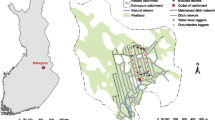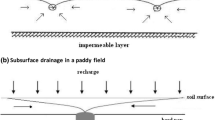Abstract
The concept of a cold air ‘Parcel’ is introduced for describing the bulk properties of drainage flow. By means of a model based on the momentum and sensible heat transports under calm conditions, the thickness h and velocity u of the Parcel are derived in simple forms. It is shown that h and u correspond to the inversion height and maximum velocity of actual drainage flow. The governing parameters for h and u are the length and vertical drop of the slope, potential temperature difference between the ambient atmosphere and the Parcel, aerodynamic condition of the slope surface expressed by the mean bulk coefficients, and ambient stability. The mean bulk coefficients depend on the roughness lengths for the velocity and potential temperature profiles and are decreasing functions of the slope length.
The Parcel Model agrees qualitatively with Manins and Sawford's (1979) model under neutral ambient stratification. But agreement is not so good under stable conditions. The thickness and velocity of drainage flow predicted by the Parcel Model agree with observations on slopes several tens of meters to several hundred kilometers long.
Similar content being viewed by others
References
Adachi, T.: 1983, ‘Numerical Simulation of Strong Katabatic Winds at Syowa and Mizuho Stations, Antarctica’, Mem. Natl. Inst. Polar Res., Spec. Issue, No. 29, pp. 50–60.
Adachi, T. and Kawaguchi, S.: 1984, ‘Numerical Simulation of Katabatic Wind at Mizuho Station, East Antarctica’, Mem. Natl. Inst. Polar Res., Spec. Issue, No. 34, pp. 37–53.
Atkinson, B. W.: 1981, Meso-Scale Atmospheric Circulations, Academic Press, New York, 495 pp.
Banta, R. and Cotton, W. R.: 1981, ‘An Analysis of the Structure of Local Wind Systems in a Broad Mountain Basin’, J. Appl. Meteorol. 20, 1255–1266.
Briggs, G. A.: 1981, ‘Canopy Effects on Predicted Drainage Flow Characteristics and Comparisons with Observations’, preprint volume of extended abstracts: Fifth Symposium on Turbulence, Diffusion, and Air Pollution, pp. 113–115.
Clements, W. E. and Nappo, C. J.: 1983, ‘Observations of a Drainage Flow Event on a High-Altitude Simple Slope’, J. Climate Appl. Meteorol. 22, 331–335.
Defant, A.: 1933, ‘Der Abfluss schwerer Luftmassen auf geneigtem Boden, nebst einigen Bemerkungen zur Theorie stationärer Luftströme’, Sitz. Ber. Preuss. Akad. Wiss. (Phys. Math. Klasse) 18, 624–635.
Dickerson, M. H. and Gudiksen, P. H. (eds.): 1983, Atmospheric Studies in Complex Terrain, Tech. Progress Rep. 1979–1983, ASCOT 84-1, Lawrence Livermore National Lab. Univ. of California, 376 pp.
Dohkoshi, J., Horiguchi, I., and Tani, H.: 1985, ‘An Observational Study on the Nocturnal Cooling at Hayakita and Oiwake, Hokkaido’, Rep. Spec. Res. Proj. Natural Disaster, No. A-60-4, pp. 167–178 (in Japanese).
Fitzjarrald, D. R.: 1984, ‘Katabatic Wind in Opposing Flow’, J. Atmos. Sci. 41, 1143–1158.
Garrett, A. J.: 1983, ‘Drainage Flow Prediction with a One-Dimensional Model Including Canopy, Soil and Radiation Parameterizations’, J. Climate Appl. Meteorol. 22, 79–91.
Gutman, L. N.: 1983, ‘On the Theory of the Katabatic Slope Wind’, Tellus 35A, 213–218.
Horst, T. W. and Doran, J. C.: 1986, ‘Nocturnal Drainage Flow on Simple Slopes’, Boundary-Layer Meteorol. 34, 263–286.
Imaoka, E.: 1964, ‘Relation Between Down Slope Wind and General Wind’, J. Agric. Meteorol. 20, 41–45 (in Japanese with English summary).
Kawaguchi, S., Kobayashi, S., Ishikawa, N., Ohata, T., Inoue, J., Satow, K., and Nishimura, H.: 1985, ‘Aerological Sounding of Lower Atmospheric Layer over Mizuho Plateau, East Antarctica’, JARE Data Rep., No. 104, 128 pp.
Kondo, J.: 1984, ‘Effect of the Topographical and Ground Surface Conditions on the Nocturnal Drainage Wind and Cooling in Mountainous Regions (Part 1)’, Tenki 31, 625–632 (in Japanese).
Kondo, J. and Kuwagata, T.: 1984, ‘A Relation Between the Depth of Nocturnal Stable Layer (Cold-Air-Pool) and the Topographical Depth of the Basin’, Tenki 31, 727–737 (in Japanse).
Kudo, T., Tanaka, H., Toritani, H., and Hwang, S.: 1982, ‘Formation of Cold Air Lake in Sugadaira Basin’, Geogr. Rev. Japan 55, 849–856 (in Japanese with English abstract).
Manins, P. C. and Sawford, B. L.: 1979, ‘A Model of Katabatic Winds’, J. Atmos. Sci. 36, 619–630.
Martin, S.: 1975, ‘Wind Regimes and Heat Exchange on Glacier de Saint Sorlin’, J. Glaciol. 14, 91–105.
Ohata, T. and Higuchi, K.: 1979, ‘Gravity Wind on a Snow Patch’, J. Meterol. Soc. Japan 57, 254–263.
Ohata, T., Ishikawa, N., Kobayashi, S., and Kawaguchi, S.: 1983, ‘Micro-Meteorological Data at Mizuho Station, Antarctica in 1980’, JARE Data Rep., No. 79, 374 pp.
Ohata, T., Kondo, H., and Enomoto, H.: 1984, ‘Drainage Flow Observed on Glacier San Rafael’, Proceedings of 1984 Spring Convention Japan Meteorol. Soc. 45, 95 (in Japanse).
Prandtl, L.: 1952, Essentials of Fluid Dynamics, Blackie and Son Ltd., London and Glasgow, 452 pp.
Rao, P. K. and Snodgrass, H. F.: 1981, ‘A Nonstationary Nocturnal Drainage Flow Model’, Boundary-Layer Meteorol. 20, 309–320.
Reiher, M.: 1936, ‘Nächtlicher Kaltluftfluss an Hindernissen’, Bioklim. Beiblätter (Braunschweig) 3, 152–163.
Sato, T. and Kondo, J.: 1985a, ‘Modeling of the Nocturnal Drainage Wind (Part 1)’, Rep. Spec. Res. Proj. Natural Disaster, No. A-60-4, pp. 349–368 (in Japanese).
Sato, T. and Kondo, J.: 1985b, ‘Modeling of the Nocturnal Drainage Wind (Part 2)’, Rep. Spec. Res. Proj. Natural Disaster, No. A-60-4, pp. 369–386 (in Japanese).
Tanaka, Y., Fujiwara, K., and Kobayashi, D.: 1983, ‘Nocturnal Cooling in the Shallow Valley and on the Plateau, (2) Topographical Dependence of Cooling Process’, J. Agric. Meteorol. 39, 213–217 (in Japanese with English summary).
Tanaka, Y., Ishigaki, K., Fujiwara, K., and Kobayashi, D.: 1982, ‘Nocturnal Cooling in the Shallow Valley and on the Plateau, (1) Cooling Process in the Valley and on the Side Slope’, J. Agric. Meteorol. 38, 245–251 (in Japanse with English summary).
Yamada, T.: 1981, ‘A Numerical Simulation of Nocturnal Drainage Flow’, J. Meteorol. Soc. Japan 59, 108–122.
Yamada, T.: 1983, ‘Simulations of Nocturnal Drainage Flows by a q 2 l Turbulence Closure Model’, J. Atmos. Sci. 40, 91–106.
Author information
Authors and Affiliations
Rights and permissions
About this article
Cite this article
Kondo, J., Sato, T. A simple model of drainage flow on a slope. Boundary-Layer Meteorol 43, 103–123 (1988). https://doi.org/10.1007/BF00153975
Received:
Issue Date:
DOI: https://doi.org/10.1007/BF00153975




